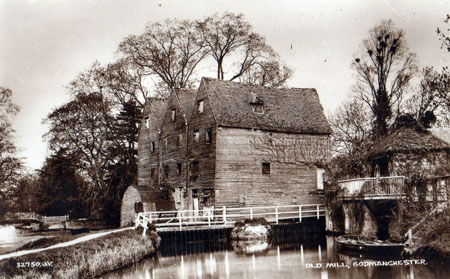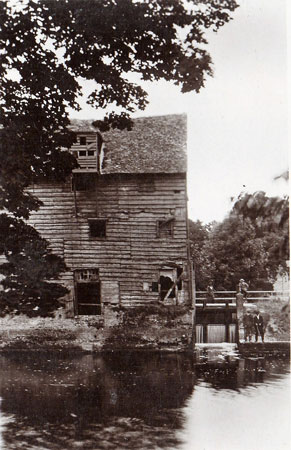The Old Godmanchester Mill once stood in what is now the car park off Post Street next to Island Hall Insurance  Brokers. A very picturesque three gabled building, mostly of timber construction, it was demolished in the 1920's. If it had survived to be restored, what an asset it would have been to the town. The Mill's origins are lost in the mists of time but it is known to have been very ancient. A cut was made from the main river to give the necessary fall and flow to provide the power for the mill wheel. It is known that mills were in operation in Roman times, probably on the same sites on which later ones were built.
Brokers. A very picturesque three gabled building, mostly of timber construction, it was demolished in the 1920's. If it had survived to be restored, what an asset it would have been to the town. The Mill's origins are lost in the mists of time but it is known to have been very ancient. A cut was made from the main river to give the necessary fall and flow to provide the power for the mill wheel. It is known that mills were in operation in Roman times, probably on the same sites on which later ones were built.
The Watermill operated six large grinding stones, one of which was a 'grist' stone always set aside for the use of the poor people of the Borough and the Godmanchester Freemen. In the latter half of the 19th Century an application was made to the Lords of the Treasury by the Corporation (who then owned the mill) for permission to sell. This was strongly opposed by Mr Thomas Maile on the grounds that the poor and the Freemen would lose their rights to the use of the 'Grist stone'.
The mill's first known tenant was John Stokes who leased the mill in 1499. A clause in the lease stated that his wife was not allowed to visit the mill or interfere with the machinery - which leaves their relationship open to interpretation. By the turn of the century the annual rent was £200 a considerable sum in those days, perhaps too much as shortly afterwards it went into decline.
 Some small cottages ran down the side of Mill Yard which were occupied by the Foreman and other workers. The Mill normally employed ten workmen with others depending on the workload. A large wagon shed fronted Post Street to house the large double shafted wagons onto which the milled flour was laden early in the morning, for long journeys pulled by a team of four cart horses. One can imagine what a hive of activity it must have been as the heavily loaded wagons arrived with their sacks of grain, the hustle and bustle as the sacks were hoisted through the trapdoors on the different floors, the warm freshly milled flour pouring down the chutes and into the bins. When the Mill was in operation a red flag was hoisted on a tall flagpole on what is now the Recreation Ground. The purpose of this was to communicate with a miller who operated a small mill on a backwater off Mill Common, in order to regulate the supply of water although how this was accomplished I do not know. This practice was abandoned by the turn of the century.
Some small cottages ran down the side of Mill Yard which were occupied by the Foreman and other workers. The Mill normally employed ten workmen with others depending on the workload. A large wagon shed fronted Post Street to house the large double shafted wagons onto which the milled flour was laden early in the morning, for long journeys pulled by a team of four cart horses. One can imagine what a hive of activity it must have been as the heavily loaded wagons arrived with their sacks of grain, the hustle and bustle as the sacks were hoisted through the trapdoors on the different floors, the warm freshly milled flour pouring down the chutes and into the bins. When the Mill was in operation a red flag was hoisted on a tall flagpole on what is now the Recreation Ground. The purpose of this was to communicate with a miller who operated a small mill on a backwater off Mill Common, in order to regulate the supply of water although how this was accomplished I do not know. This practice was abandoned by the turn of the century.
What a shame this historic building is lost forever and I cannot help but wish we could follow the example of the Americans in rebuilding our old structures, as they have done in Williamsburg, Virginia, where they have re-constructed the entire Colonial town. Although I doubt the Mills original plans exist, many old photographs do, which give a good idea as to its structure. Just a pipe dream but wouldn't it be a wonderful project for the future.
Contributed by Anne Sink